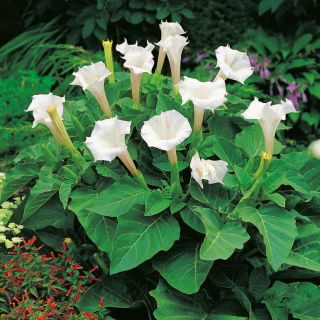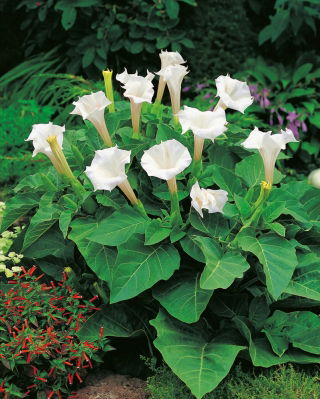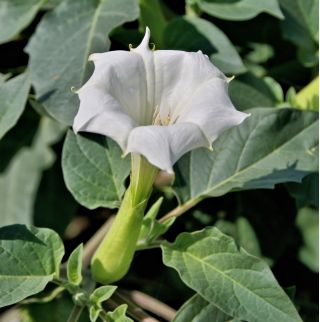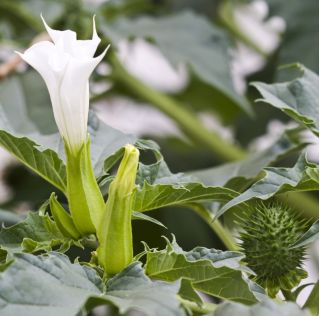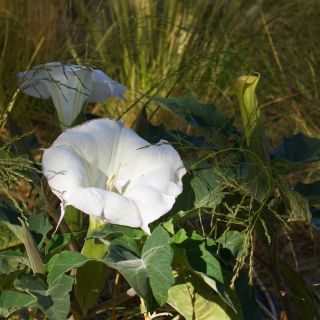The Indian thornapple, known scientifically as Datura metel, is a remarkable annual plant that captivates with its striking white trumpet-shaped flowers. Reaching a height of 60 to 100 cm, it blends beautifully in groups on flower beds, forming sprawling bushes with large, dark green leaves. Due to its beauty and ease of cultivation, the Indian thornapple is an excellent choice for large containers, adding charm to terraces and balconies. It is highly regarded by gardeners for its ability to adapt to various conditions.
Sowing
Sow Indian thornapple seeds under cover for best results. In suitable conditions, the seeds germinate quickly, allowing for the development of robust plants ready for transplanting to their permanent location. It is crucial to provide them with consistent moisture to promote healthy growth and abundant flowering.
Sowing Depth
Place the seeds at a depth of approximately 1 cm. This positioning offers optimal conditions for germination, protecting them from excessive drying and ensuring access to essential nutrients.
Sowing Period Under Cover
When is the best time to sow Indian thornapple seeds under cover? February and March are ideal months. Early sowing encourages the plant's development, preparing it for outdoor planting once the risk of frost has passed.
Planting Time
The best time to plant Indian thornapple in the garden is mid-May. By this time, the plants are strong enough to withstand changing weather conditions and can quickly begin flowering.
Plant Spacing
When planting Indian thornapple, maintain a spacing of 40x40 cm. This space ensures adequate air circulation, minimising the risk of fungal diseases and promoting lush branching.
Companion Planting
The Indian thornapple pairs wonderfully with other plants of similar height, such as dahlias and zinnias. Together, they create harmonious compositions that captivate with their rich colours and forms.
Site Conditions
The Indian thornapple prefers sunny locations where it can bask in ample light to develop its magnificent flowers. The soil should be fertile, humus-rich, and well-drained. Regular fertilisation and moderate watering provide the plant with optimal growth conditions.
Growing Tips
Growing Indian thornapple is relatively straightforward. Regularly removing spent flowers stimulates the plant to continue blooming. It's also important to ensure adequate watering, especially during dry spells, to prevent wilting of leaves and flowers.
Plant Height
The Indian thornapple reaches a height of 60 to 100 cm, making it an excellent choice for creating stunning vertical accents in the garden.
Flowering Period
The Indian thornapple blooms from July to September, offering a long period of decorative appeal. Its impressive flowers draw attention and add elegance to any garden arrangement.
Usage
The Indian thornapple excels in large pots on terraces and balconies, where its presence adds charm and elegance. It is also a perfect choice for flower beds, where it combines with other plants to create harmonious compositions. Its flowers can serve as a unique decorative element in both formal and rustic gardens.
Resistance to Diseases
The Indian thornapple demonstrates good resistance to most common garden diseases, making it easy to cultivate. Regular monitoring and providing appropriate growing conditions further enhance its resistance.
Good to Know
In addition to its decorative nature, the Indian thornapple has an intense fragrance that attracts pollinating insects. However, it is worth noting that this plant is toxic, so caution is advised during its care, especially in the presence of children and pets.
Why Buy from Garden Seeds Market
By choosing to purchase Indian thornapple seeds from Garden Seeds Market, you can be assured of the highest quality seeds that have undergone meticulous laboratory testing. The store offers a wide selection of premium seeds that guarantee healthy and vigorous plant growth. Customers appreciate the fast delivery, secure shopping, and expert advice. Numerous positive reviews from satisfied customers attest to the store's reliability and professionalism.
The packet contains 0.3 g of seeds. The packaging includes information on cultivation guidelines and the sow-by date.

